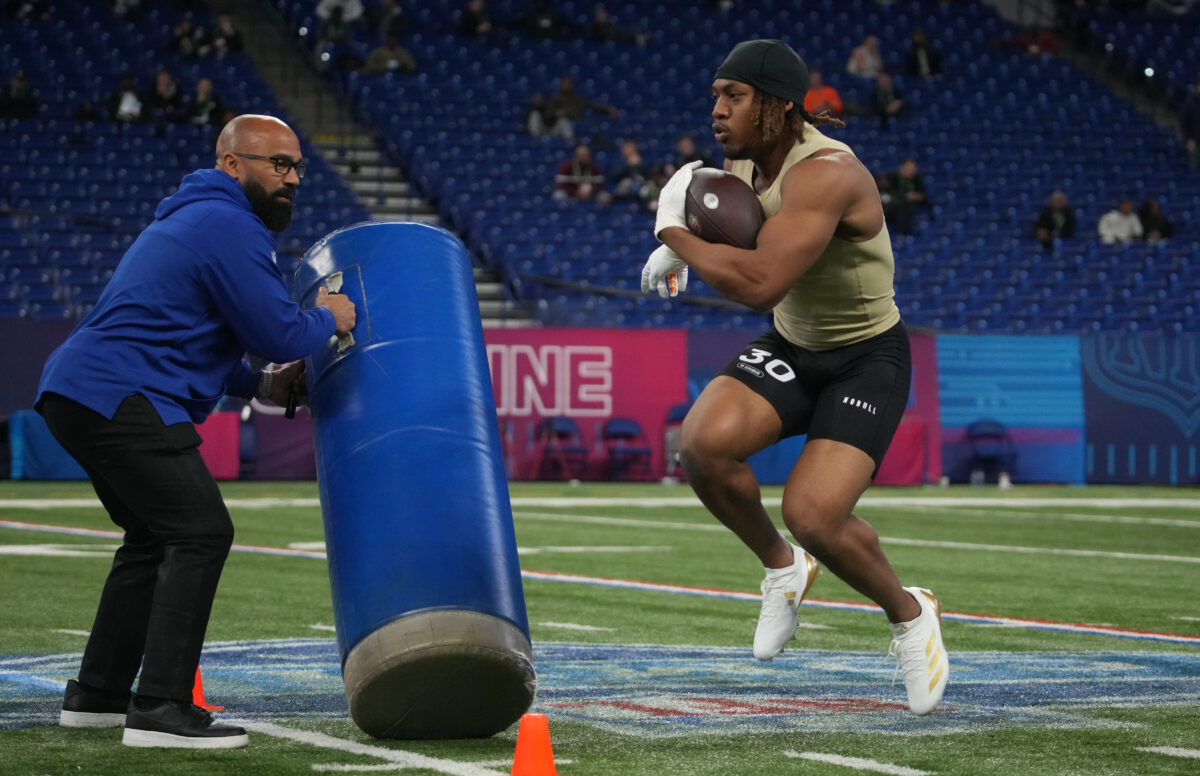It’s not a matter of if the Green Bay Packers are going to draft a running back, but rather when will they make that move? With athletic testing playing a key role in the draft selections that Brian Gutekunst makes, here were the top performers at the running back position.
Relative Athletic Scores allow us to compare prospects within a position group through the lens of one simple figure. In short, the closer a prospect scores to 10 on the RAS scale, the better the athlete.
Gutekunst has made 54 draft picks during his tenure that have registered on the RAS scale and 40 of them have scored 8.0 or higher, with 25 of those 40 above the 9.0 mark. And, oftentimes, the earlier the pick in the draft, the higher the RAS.
To learn more about RAS and its connection to the Packers’ draft classes, click here.
With that said, running back is where we’ve seen a bit of a deviation from those aforementioned figures–although it is a small sample size. Gutekunst has selected four running backs, and two of them, Dexter Williams and AJ Dillon, scored above 8.0, with Dillon posting a RAS of 9.15.
Lew Nichols and Kylin Hill – two seventh round picks – were close, scoring 7.83 and 7.28, respectively, but both just shy of the line in the sand that has been drawn at 8.0.
Following the NFL Combine, below you will find all of the running backs who posted a RAS of 8.0 or higher.
Isaac Guerendo, Louisville: 9.98
Tyrone Tracy Jr., Purdue: 9.87
Jaylen Wright, Tennessee: 9.81
Trey Benson, Florida State: 9.77
MarShawn Lloyd, USC: 9.29
Dylan Laube, New Hampshire: 9.21
Kimani Vidal, Troy: 8.84
Isaiah Davis, South Dakota State: 8.73
Kendall Milton, Georgia: 8.68
Audric Estime, Notre Dame: 8.59
Blake Corum, Michigan: 8.48
George Holani, Boise State: 8.44
The Packers and Aaron Jones’ need to come to an agreement on a reworked contract, whether that be through a restructure, or Jones taking a pay cut, to lower his hefty $17.1 million cap hit for the 2024 season.
However, I’m guessing the Packers want to avoid a restructure if possible, given that this is the final year of Jones’ contract, and he already comes with a dead cap hit of $6.63 million in 2025 before another restructure takes place.
Although there is still work to be done to lower Jones’ cap hit, Gutekunst was pretty direct during his season-ending press conference in saying he wants Jones to be back this season–and why wouldn’t he? Jones’ impact on this offense when healthy is massive, and not only in the run game, but the passing game as well.
“He changed a lot of the way we operated when he was in there and healthy,” Gutekunst said. “For us, it’s finding a way to keep him out there and keeping him healthy. He’s such an influential leader in our locker room. The heartbeat of our team.”
But, even with Jones likely returning, behind him on the depth chart is a major unknown. AJ Dillon is a free agent, and Tom Silverstein recently reported that he isn’t expected to return. This leaves the Packers with Emanuel Wilson – once he’s officially back as an exclusive rights free agent – and Ellis Merriweather at the running back position.
Perhaps Wilson can earn the second running back role or at least additional responsibilities this season, but there will absolutely be competition for that playing time that takes place this summer.
What the Packers need behind Jones is another dynamic presence. With the Packers again going to be mindful of Jones’ snap count, that second running back is going to get his share of touches. And while Dillon was reliable, he was limited, averaging just 3.4 yards per carry this past season.
Even if the Packers do end up moving on from Dillon, which is the direction that the wind is blowing, that doesn’t mean there won’t be a Dillon-like presence on the roster at running back. In fact, having that skill set is important to Gutekunst.
“I do think we would always like to have one power, bigger back on the roster for short-yardage situations and playing in the weather and closing out games,” Gutekunst said via Packers.com.
Along with the obvious need for a running back to be effective with the ball in his hands, what can’t be overlooked is the importance of pass-blocking and pass-catching at that position within the Packers’ offense, something both Gutekunst and Matt LaFleur have discussed in the past. It’s these elements that not only determine playing time, but roster spots as well.
As Gutekunst said, the offense operates differently when Jones is on the field, and although not many can impact the game as he does, what the Packers need is more playmaking when he isn’t out there. There’s, of course, the big-play ability that a home run presence can bring, but when the defense is mindful of the run, that then opens up opportunities in the passing game for the offense as well.
The Packers addressing the running back position also isn’t solely about 2024 either; as already mentioned, this is the final year of Jones’ deal, which means it could be his last in Green Bay. And whether or not that is the case, the Packers need to prepare like it’s going to be.
